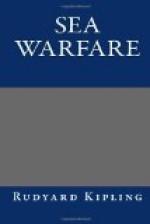THREE DESTROYERS
A little time after the action began to heat up between our battle-cruisers and the enemy’s, eight or ten of our destroyers opened the ball for their branch of the service by breaking up the attack of an enemy light cruiser and fifteen destroyers. Of these they accounted for at least two destroyers—some think more—and drove the others back on their battle-cruisers. This scattered that fight a good deal over the sea. Three of our destroyers held on for the enemy’s battle-fleet, who came down on them at ranges which eventually grew less than 3000 yards. Our people ought to have been lifted off the seas bodily, but they managed to fire a couple of torpedoes apiece while the range was diminishing. They had no illusions. Says one of the three, speaking of her second shot, which she loosed at fairly close range, “This torpedo was fired because it was considered very unlikely that the ship would escape disablement before another opportunity offered.” But still they lived—three destroyers against all a battle-cruiser fleet’s quick-firers, as well as the fire of a batch of enemy destroyers at 600 yards. And they were thankful for small mercies. “The position being favourable,” a third torpedo was fired from each while they yet floated.
At 2500 yards, one destroyer was hit somewhere in the vitals and swerved badly across her next astern, who “was obliged to alter course to avoid a collision, thereby failing to fire a fourth torpedo.” Then that next astern “observed signal for destroyers’ recall,” and went back to report to her flotilla captain—alone. Of her two companions, one was “badly hit and remained stopped between the lines.” The other “remained stopped, but was afloat when last seen.” Ships that “remain stopped” are liable to be rammed or sunk by methodical gun-fire. That was, perhaps, fifty minutes’ work put in before there was any really vicious “edge” to the action, and it did not steady the nerves of the enemy battle-cruisers any more than another attack made by another detachment of ours.
“What does one do when one passes a ship that ’remains stopped’?” I asked of a youth who had had experience.
“Nothing special. They cheer, and you cheer back. One doesn’t think about it till afterwards. You see, it may be your luck in another minute.”
LUCK
There were many other torpedo attacks in all parts of the battle that misty afternoon, including a quaint episode of an enemy light cruiser who “looked as if she were trying” to torpedo one of our battle-cruisers while the latter was particularly engaged. A destroyer of ours, returning from a special job which required delicacy, was picking her way back at 30 knots through batches of enemy battle-cruisers and light cruisers with the idea of attaching herself to the nearest destroyer-flotilla and making herself useful. It occurred to her that as she “was in a most advantageous position for repelling enemy’s destroyers endeavouring to attack, she could not do better than to remain on the ‘engaged bow’ of our battle-cruiser.” So she remained and considered things.




